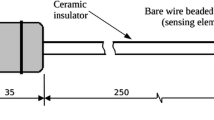Abstract
This paper presents the extraction of a boundary independent dynamic compact thermal model (DCTM). The paper specifically focuses on time-varying Dirichlet boundary conditions influence and the methodology proposed to obtain the DCTM is applied to a thermopile based infrared (IR) sensor. These type of sensors are quite sensitive to environment changes because a variation in the sensor bulk silicon temperature usually generates a different temperature influence in the hot and cold areas that can produce incorrect transient measurements of the incident IR radiation. A DCTM can be used to estimate the influence of the environmental temperature evolution in the sensor output and with the help of a temperature sensor correct the measurement of the IR incident radiation in the real device. The methodology to construct the DCTM is based in the construction of an equivalent thermal RC network, the topology of which, as well as its component values, are obtained from the analysis of the dynamic power-temperature relationship on the points of interest.















Similar content being viewed by others
References
Antoulas AC, Sorensen DC (2000) Approximation of large-scale dynamical systems: an overview. Technical Report MTNS Perpignan
Baltes H, Paul O, Brand O (1998) Micromachined thermally based CMOS microsensors. Proc IEEE 96(8):1660–1678
Calaza C, Moreno M, Marco S, Fonseca L, Cané C, Gràcia I, Fourniols JY, Soto-Romero G, Bony F (2002) Design, fabrication and characterization of CMOS compatible thermoelectric IR sensors for a gas analysis application. In: IRS2, 7th edn. pp 45–50
Calaza C, Meca E, Marco S, Moreno M, Samitier J, Fonseca L, Gràcia I, Cané C (2003) Assessment of the final metrological characteristics of a MOEMS-based NDIR spectrometer through system modeling and data processing. IEEE Sens J 3(5):587–594
Coleman TY, Li Y (1996) An interior, trust region approach for nonlinear minimization subject to bounds. SIAM J Optimi 6:418–455
Elbel T, Lenggenhager R, Baltes H (1992) Model of thermoelectric radiation sensors made by CMOS and micromachining. Sens Actuat A 35:101–106
Freund RW (2000) Krylov-subspace methods for reduced-order modeling in circuit simulation. J Comp App Math 123:395–421
Gerstenmaier YC, Pape H, Wachutka G (2001) Boundary independent exact thermal model for electronic systems. In: MSM, 4th edn, pp 84–87
Götz A (1997) Integrated microsensors for microsystems with applications in biomedicine and environmental control. Ph.D. thesis, Universitat Autònoma de Barcelona
Jain AK, Zongker D (1997) Feature selection: evolution, application and small sample performance. IEEE Trans Pattern Anal Mach Intell 19(4):153–158
Kailath T (1979) Linear systems. Prentice Hall, Englewood Cliffs
Palacín J, Salleras M, Puig M, Samitier J, Marco S (2004) Evolutionary algorithms for compact thermal modelling of microsystems: application to a micro-pyrotechnic actuator. J Micromech Microeng 14(7)1074:1082
Rencz M, Székely V (2001) A generic method for thermal multiport model generation of IC packages. In: IEEE SEMI-THERM, 17th edn, pp 145–152
Rencz M, Székely V (2003) Non-linearity issues in the dynamic compact model generation. In: IEEE SEMI-THERM, 19th edn, pp 263–270
Rencz M, Farkas G, Székely V, Poppe A, Courtois B (2003) Boundary condition independent dynamic compact models of packages and heat sinks from thermal transient measurements. In: ETPC, 5th edn, pp 479–484
Rudnyi EB, Korvink JG (2002) Automatic model reduction for transient simulation of MEMS-based devices. Sensors Update 11:3–33
Sabry MN (2001) Compact thermal models for electronic systems. In: THERMINIC, 7th edn, pp 197–202
Salleras M, Palacín J, Puig M, Samitier J, Marco S (2003) Development of a compact thermal model for micro-pyrotechnic actuator. In: EuroSimE, 4th edn, pp 299–304
Socher E, Degani O, Nemirovsky Y (1998) Optimal design and noise considerations of CMOS compatible IR thermoelectric sensors. Sens Actuat A 71:107:115
Acknowledgements
This work has been supported by the Spanish Ministry for Science and Technology. Project MCYT n° DPI-2001-3213-C02-01.
Author information
Authors and Affiliations
Corresponding author
Rights and permissions
About this article
Cite this article
Salleras, M., Palacín, J., Moreno, M. et al. A methodology to extract dynamic compact thermal models under time-varying boundary conditions: application to a thermopile based IR sensor. Microsyst Technol 12, 21–29 (2005). https://doi.org/10.1007/s00542-005-0016-8
Received:
Accepted:
Published:
Issue Date:
DOI: https://doi.org/10.1007/s00542-005-0016-8




